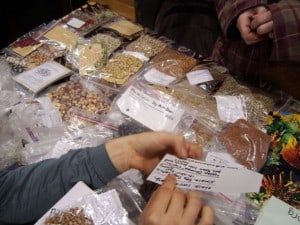The world could always use more seed swaps and here are a few tips for organizing your own Seed Swap. (Thanks to Kim in central Virginia for the e-mail prompting this blog post.)
The folks at Seedy Sunday Brighton have a whole page devoted to hosting a seed swap. Food not Lawns also has a bit about organizing one.
The first thing is to get some friends involved, because it can be a lot of work (organizing, set up, clean up, promotion, etc.). If you don’t know anyone that will help you, post some fliers at garden stores or your local natural foods store, or maybe even the community garden bulletin board if your community is lucky enough to have one.
We have seen a few ways seed swaps can be organized. You have to decide which is best for your group.
Seedy Sunday Brighton has a central table, and when people come in, they give their seeds to the table, then volunteers organize them for redistribution. This way seems overly centralized and impersonal to me, but it works for them, and it may be necessary to do it this way at an event that draws upwards of 1,000 people. They also charge a small entrance fee to cover their expenses and require either a straight across swap of seed for seed or 50 pence for a seed pack, partly because “people don’t value that which is free.” At every other seed swap I have been to, everything is free.
A second way is to set up tables and have people stand near their stuff, so they can explain it to others that might have questions. This is what we do at the smaller fall seed swap.
A third way, which is also good, is to set up tables and have designated areas for different types of plants: flowers, herbs, tomatoes, etc. this is what we do at our large spring seed swap.
Most seed swaps descend into a sort of chaos even with the rough framework, so you could just have some tables and have people toss their seeds wherever they land. Then it’s a real treasure hunt!
Some other tips:
* If the group is 30 people or less, it is nice to stand in a circle and have people introduce themselves and what they’ve brought. This gives the swap more of a community vibe.
* If you know any seed geeks or old gardener types, be sure and personally invite them to help ensure there are some good seeds there.
* In your promotional materials, remind people to bring envelopes, tea packets, or paper to make origami cups. As an organizer, be sure to bring plenty for those that have forgotten.
* It is also good to bring pens and tape them to a string attached to the table, so people can label as they pack up their seeds.
* Remind people at the event to clearly label everything they’ve brought to the best of their ability.
* Ask that people deflate and then close the bags/packets when they are done with them. Ask a few volunteers to go around closing bags that were left open.
* Some seed swaps have a rule that people only take 1/2 or less of the seed from each bag/package. I prefer to remind people to only take that which they are sure to plant or sure to share with others.
* On your fliers, make sure to note that people are welcome to come empty-handed, or may bring potted plants and root divisions, or anything they have a surplus of, whether it be dried herbs and tinctures, jams, winter squash, honey, home brew, etc.
* A bouquet of flowers really makes it feel nice.
* If your group is passionate about seed saving, consider inviting people to form a Seed Sovereignty Network, also known as a Seed Circle, where people can coordinate future seed grow-outs: someone grows Red Russian kale, someone grows rutabaga (hopefully these two aren’t neighbors, as they will cross-pollinate), someone grows beets, someone grows chard, etc. This is especially good if the people are city folk and don’t have space for lots of large seed grow-outs, but maybe can do one or two species that require large populations.
* Print up a few dozen copies of our seed saving zine. This file is ready to be printed with two-sided printing (duplex), so if you do not have two-sided printing ability you can print one page at a time and flip them over and back in the printer for the back side of the page. Offer them for free or for sale by donation (donations for you, not us). It usually costs us about $1.50 per copy to print them, and we ask sliding scale of $2 – $5 to help cover our gas costs and whatnot (we live about an $8 drive from town).
* Bring a broom and dustpan to sweep up the potpourri of seeds that get spilled. Then ceremoniously sprinkle them in unplanted garden beds around the swap.
* If you have lots of seed, or older seed of questionable germination, consider having a seed ball making playshop for kids and adults. (Just google seed balls for loads of how-to’s).
If this is your community’s first seed swap, don’t be surprised if people only bring leftover commercial seed packets. As people get more excited about and familiar with seeds and seed saving, the commercial seed packs all but disappear.
That’s it for the moment. If anyone has any other tips to add, please do!

Leave a Reply